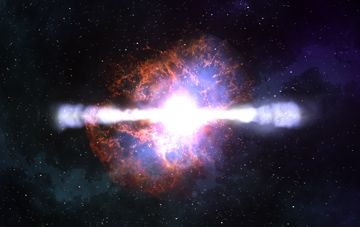New Explanation for the Greatest Cosmic Explosions

There is a certain type of cosmic explosion that becomes, ina flash, the brightest thing in the universe, emitting for a few seconds asmuch radiation as a million galaxies. Don't bother looking for one in the sky,though, since most of the light is in the gamma-ray part of the spectrum, a realmwe can't see.
Astronomers observe these colossalgamma-ray bursts with space-based telescopes, however.
They generally agree that only the birth of a black hole could supply enoughspark for one of these intense flashes, but there remains a great deal ofuncertainty over what converts the newborn black hole's energy into theradiation that astronomers detect.
Recent observations suggest that this "converter"is a high-powered magnetic beam, and not--as many theorists believe--a high-speedjet of hot material.
This is just the latest debate over these exceptionallyluminous objects called gammaray bursts. Researchers previously argued whether GRBs come from inside oroutside our galaxy, then whether they emerge from a dying star or two neutronstars merging.
The current consensus is that most GRBs are the death knellof a massive star in a faraway galaxy. After exhausting its fuel supply, the star'score collapses into a black hole (or a comparatively dense neutron star),which acts as a "central engine" for two jets spouting out of thepoles.
These jets are where the energy of thecollapse is transformed into gamma rays, but we only observe a GRB if wehappen to be lined up with the barrel of one of the jets.
Breaking space news, the latest updates on rocket launches, skywatching events and more!
This overall picture is fairlywell-established, but the big question, according to Tsvi Piran of the Hebrew University in Jerusalem, is what makes up the jets.
When you're a jet
The widely-accepted fireball model assumes that the outershells of the dying star are heated to very high temperature. This hot materialexpands outward in all directions, but the expansion is easiest along thestar's rotational axis. Hence, fast moving material emerges from the poles astwin jets.
But the Swift satellite, NASA's dedicated GRB observatory,has detected a number of GRBs that appear to defy the fireball model.
"Swift has seen many puzzling GRBs," Piran told SPACE.com."I would say about half the cases have something unexpected."
Of the more than 200 GRBs that Swift has recorded, some havehad verylong X-ray afterglows, while others have faded away and then suddenlyrebrightened.
"What we are finding is that the central engine is notdying immediately but continues to inject energy into the flow for thousands ofseconds," said theorist Dimitrios Giannios of the Max Planck Institute forAstrophysics in Garching, Germany. "This long activity is more consistentwith magnetic models."
A star's magnetic fields is compressed and amplified whenthe star collapses to a black hole or a highly magnetized neutron star, calleda magnetar.Models predict that the fields are strongest--roughly a million billion timesthat of Earth's magnetic field--along the rotational axis, where they spiralout like an ever-widening corkscrew, according to Giannios.
Since magnetic fields have no mass, they are much easier to acceleratethan matter. The fields would therefore be more efficient at carrying energyout of the central engine.
Outward-moving magnetic fields would eventually dissipate theirenergy into gamma rays--most likely in a process similar to whathappens in solar flares, said Erin McMahon of the University of Texas at Austin.
Theories predict that this gamma ray production occurs 10billion miles from the central source, roughly 100 times further out than thefireball model. McMahon and her colleagues recently studied a sample of 10 GRBsand found that the estimated location of gamma ray emission was more consistentwith magnetic outflows.
Polarized opposite
It is not easy to confirm the presence of magnetic fields infar-off astronomical objects, but the light coming from a magnetized sourceshould be polarized, which means the light's electric field should point in aspecific direction.
"The polarization gives you a handle on the magneticfields," said astronomer Carole Mundell of Liverpool John Moores University in the UK.
Mundell and her colleagues have built a polarizationdetector for GRBs--which is not an easy thing to do, since the light fades awayso quickly. The team recently caught their first burst, but failed to detectany polarization--apparently ruling out a strong, well-ordered magnetic field.
However, Giannios thinks that magnetic fields could beoriented in a way that hides the polarization signal. The trouble is that noone can say exactly how the fields will behave in a magneticoutflow, since astronomers have yet to observe one in any setting.
Conversely, matter-filled jets are often seen comingout of quasars.
Open field
Magnetic fields lag behind their fireballcounterparts not only observationally but theoretically too.
"We don't know how to calculate all the effects of themagnetic fields yet," Piran said. "The model does not make enoughpredictions."
Giannios agrees that magnetic outflow researchers have theirwork cut out for them, especially in explaining what makes the afterglows thatshine for minutes up to days.
"But the status has improved," Giannios said. "There have been detailed calculations [of the initialburst] and they compare well with data."
In light of all the unexpected results comingfrom Swift, it may turn out that there are two classes of GRBs: some born fromfire, others magnetically driven.
"It is a very open field right now," Giannios said. "Every day brings a new surprise."
- Alternative Theories for Gamma-Ray Bursts
- Video: The Biggest Explosions in the Universe
- Video: All About Black Holes

Michael Schirber is a freelance writer based in Lyons, France who began writing for Space.com and Live Science in 2004 . He's covered a wide range of topics for Space.com and Live Science, from the origin of life to the physics of NASCAR driving. He also authored a long series of articles about environmental technology. Michael earned a Ph.D. in astrophysics from Ohio State University while studying quasars and the ultraviolet background. Over the years, Michael has also written for Science, Physics World, and New Scientist, most recently as a corresponding editor for Physics.
